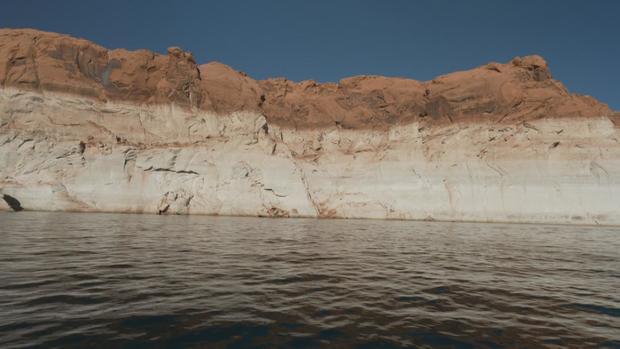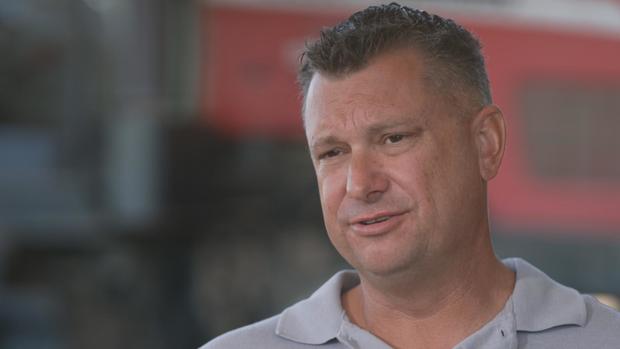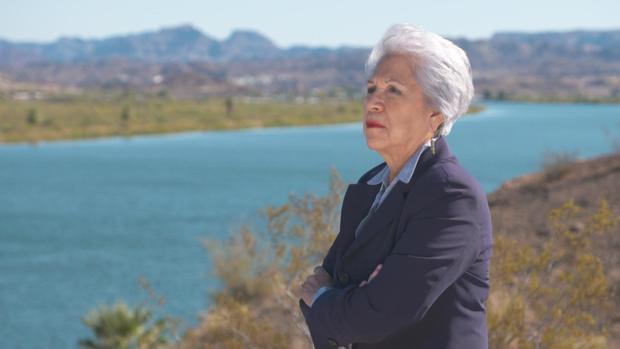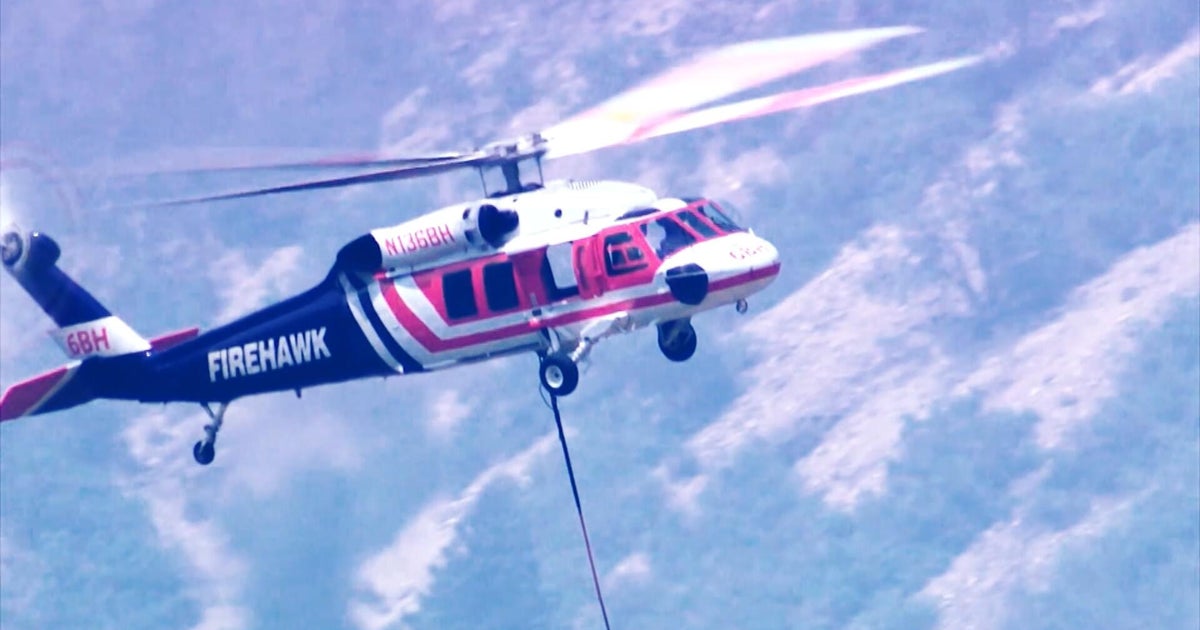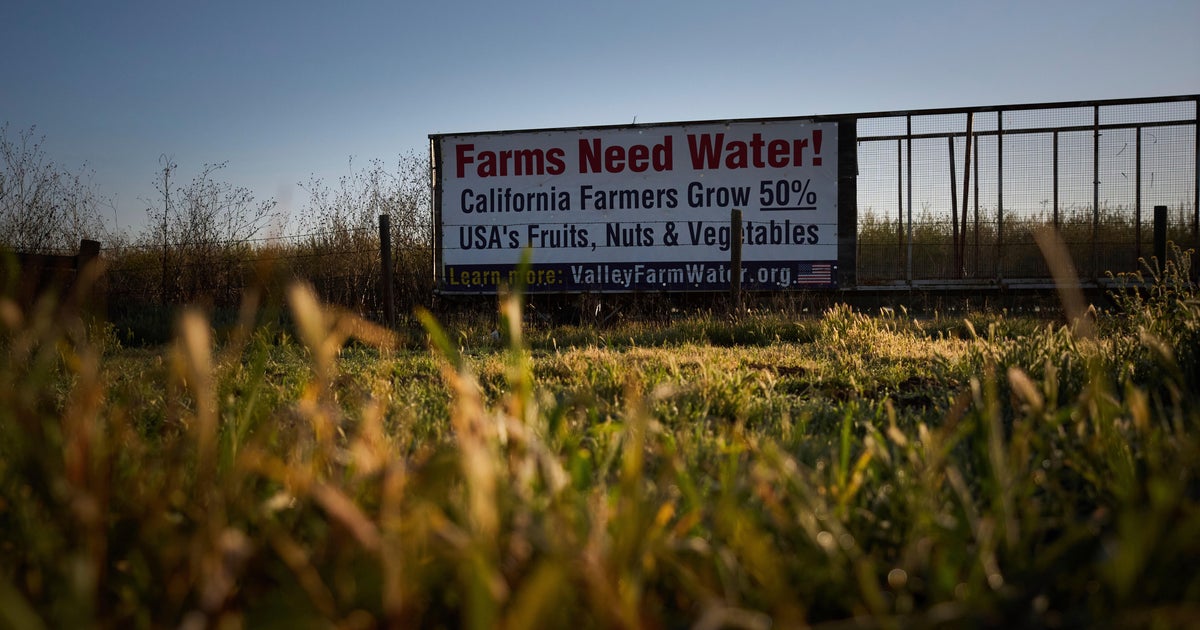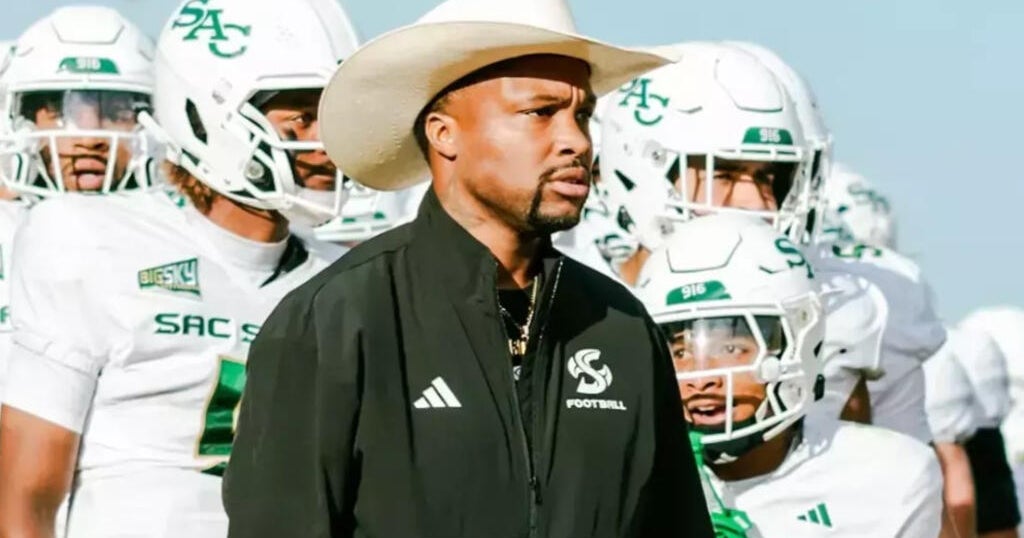Southwest states facing tough choices about water as Colorado River diminishes
This past week, California declared a statewide drought emergency. It follows the first-ever federal shortage declaration on the Colorado River, triggering cuts to water supplies in the Southwest. The Colorado is the lifeblood of the region. It waters some of the country's fastest-growing cities, nourishes some of our most fertile fields and powers $1.4 trillion in annual economic activity. The river runs more than 1,400 miles, from headwaters in the Rockies to its delta in northern Mexico where it ends in a trickle. Seven states and 30 Native American tribes lie in the Colorado River Basin. Lately, the river has been running dry due to the historically severe drought.
The majestic, meandering Colorado River that cut through these red cliffs, carving the Grand Canyon, is a wonder of nature and human ingenuity. The Glen Canyon Dam created Lake Powell and 300 miles down river Lake Mead sits behind the Hoover Dam. These reservoirs are now being sucked dry by 40 million different straws - that's the number of people in booming western states who depend on the Colorado to quench their thirst, power their homes, water lawns and splash in the sun. Its waters irrigate farms that produce 90% of the country's winter greens. To all these demands add the stress of a 22 year drought - as dry as any period in 1,200 years - and you have a river in crisis.
Bill Whitaker: These white bathtub rings; is-- is this where the water used to be?
Brad Udall: Absolutely.
Brad Udall, a climate scientist at Colorado State University, went out on Lake Powell with us.
Bill Whitaker: So all of this would have been underwater?
Brad Udall: Yeah.
Bill Whitaker: So what does this tell you about what's happening on the Colorado River?
Brad Udall: Well, it's a signal of the long-term problem we've been seeing since the year 2000, which is climate change is reducing the flows of the Colorado significantly.
Lake Powell and Lake Mead, the two biggest reservoirs in the country, were nearly full in 2000. Today, they are at just about 30% capacity.
Brad Udall: The lake's now 155 feet below full. It's dropped something like 50 feet this year.
Bill Whitaker: And it's still dropping?
Brad Udall: Yes. And that's when power generation actually becomes to come into question.
Bill Whitaker: So it drops so low that it may not be able to generate--
Brad Udall: It may not be able to generate power--
Bill Whitaker: Hydroelectric power?
Brad Udall: Yeah.
Brad Udall has strong connections to the river. As secretary of the interior, his uncle, Stewart Udall, opened the Glen Canyon Dam. His father, Congressman Mo Udall, fought to channel river water to Arizona. As a young man, Brad was a Colorado River guide. Today he analyzes the impact of climate change on water resources.
Bill Whitaker: Is the west on a collision course with climate change?
Brad Udall: In some ways yes, but we have fully utilized this system. We've over-allocated it, and we now need to think about how to turn some of this back. 'Cause the only lever we control right now in the river is the demand lever. We have no control over the supply. So we have to dial back demand.
Seventy percent of Colorado River water goes to agriculture. When the federal government declared the water shortage, it triggered mandatory cutbacks. Pinal County, Arizona got hit hard.
Waylon Wuertz: Pinal County alone, we're gonna be losing 300,000 acre feet of surface water. That's water that would be delivered from Lake Powell, Lake Mead. As part of the Colorado River. 300,000 acre feet is 98 billion gallons of water.
Waylon Wuertz farms 500 acres in Pinal County, south of Phoenix. His family has tilled soil here for four generations. It's some of the most productive land in the state. Crops from Pinal County are shipped all over the country. Wuertz grows gourds, cotton and alfalfa — profitable, but thirsty crops and his allotment of Colorado River water is being cut by 70%.
Bill Whitaker: This is Colorado River water?
Waylon Wuertz: Yeah, kinda the-- the lifeline of our-- irrigated ag here.
Bill Whitaker: This comes straight in from Lake Mead?
Waylon Wuertz: Correct. This is-- through hundreds of miles of canal system. It's-- made its way down here to Central Arizona.
Bill Whitaker: And what percentage of your water is supplied by this canal?
Waylon Wuertz: It's been close to 50% of the water that we've used to-- to farm here. And-- this next year it's probably gonna drop down to about 20% of the water that we use.
That's 1/7th of what he was getting a decade ago. To use less water and make ends meet, Wuertz sold more than 300 acres to a solar farm. He dipped into retirement funds to repair and restart old wells. He laser leveled his fields to make irrigation more efficient.
Bill Whitaker: But it's just not enough in the middle of this drought.
Waylon Wuertz: No, it's not enough.
So, next year he told us he'll have to leave 150 acres uncultivated.
Waylon Wuertz: What you see green here is eventually gonna die. I hope we'll have enough water to plant it in the future. But more than likely it's gonna stay brown for quite some time.
Amelia Flores: All the water users are gonna have to give up something to keep that water in the lake.
Amelia Flores is chairwoman of The Colorado River Indian Tribes, a reservation of four tribes a few hours west of Phoenix, with the oldest and largest water rights in Arizona. After being moved to reservations, Southwest tribes got rights to about a quarter of the river's flow, but government red tape and lack of infrastructure have prevented them from using their full allotment. Flores told us until this drought, tribes were never included in water negotiations.
Bill Whitaker: Why had you not had a seat at the table before this?
Amelia Flores: Because the tribes have always been overlooked in the policymaking and-- and in-- in the law of the river. But that day has come to an end.
When western states first divvied up the Colorado River in 1922, and later, when the federal government built the Hoover and Glen Canyon Dams, the future seemed boundless and manageable. Through negotiation and court battles, states worked out agreements — the law of the river — to split the water equally between upper and lower basin states. The lower states use just about all their allotment and it's fed their tremendous growth. The upper states have never used their full share. Now, they are booming and say they need the water they've been promised.
Bill Whitaker: I can see the bathtub rings around here too.
Zach Renstrom: We're trying to keep every drop of water we can into this reservoir for next year's drinking water.
Zach Renstrom manages the water system for Washington County in southwest Utah. St. George, the county seat, is one of the fastest growing metro areas in the U.S. Its population grew 29% this past decade. The state of Utah gets about a quarter of its water from the Colorado, but most of Washington County has only one source, the Virgin River, which fills this reservoir.
Zach Renstrom: So right now we're in the process of implementing really strict conservation measures. And if the cities don't adopt those standards then we'll be out of water very quickly.
Bill Whitaker: What is very quickly?
Zach Renstrom: Within the next five to ten years.
So, in the midst of this drought, Utah is proposing to build a $1-billion to $2-billion pipeline able to bring 27 billion gallons of water a year from dwindling Lake Powell. Utah says it's entitled to the water by law.
Bill Whitaker: You're talking about siphoning off water from a lake that's already at a critically low level to help a city grow in the desert.
Zach Renstrom: Every state on the Colorado River was allotted so much water and a water budget. And so with their water budget the state of Utah has decided that it wants to use a portion of its water here in St. George, Utah.
Bill Whitaker: But it was a budget that was set when water was plentiful. It isn't anymore. What is Utah hoping for?
Zach Renstrom: Utah wants the right to do what every other basin state has done. We want to make sure that we have water for our future, for a hotter dryer scenario that's coming up.
JB Hamby: Building a multibillion dollar pipeline to pump out more water from an already rapidly declining reservoir simply doesn't make sense in the 21st century.
JB Hamby is vice president of the board that runs California's Imperial Irrigation District, one of the richest agricultural regions in the country with the single largest allocation of water on the entire river.
JB Hamby: There's a lot of urban growth and sprawl occurring in other parts of the Colorado River Basin that's really not necessarily sustainable.
Hamby says California's Imperial Valley farms have cut water usage almost 20% since 2003, but points out as the population of St. George, Utah grows, so does its water use.
JB Hamby: We need to think and rethink about how we grow and if we grow and where we grow.
Bill Whitaker: St. George would say that they're not asking for more. They're asking for what they need.
JB Hamby: I think what we all need to have is a reality check, here, and recognize that we live in an era of limits right now and that's not going away anytime soon. In fact, it's only going to get worse.
A big part of the problem is the law of the river itself, a hodgepodge of rules and regulations pieced together over the course of a century. For example, after all the litigation and negotiations, the law ends up allocating more water than actually flows down the Colorado. And this: in times of shortage, channels that provide more than a third of Arizona's water must run dry before California is required to cut back.
Bill Whitaker: So, so wait a minute, Arizona is being called on to cut its water intake before California has to give up even one drop?
Brad Udall: Pretty amazing. It can't work in today's world. And it's in some ways a little microcosm, right, of this whole law of the river with these systems that have been put in place that just don't work. They can't work. And that's why a rethink's needed.
One example of rethinking: the Colorado River Indian Tribes agreed to leave fields uncultivated, leaving 48 billion gallons — almost three feet of water — in Lake Mead. The state of Arizona agreed to pay them for their losses.
Amelia Flores: My people want to help during this drought. We want to save the river, because for centuries the river has always taken care of us, so now, we have to take care of the river.
Brad Udall: That's what negotiations are all about, right? It may be there are ways to conserve and figure out how to get the same goods and services for less water. Let's let ag grow crops that use less water. Let's figure out how to make cities use water as efficiently as possible. So, I mean, we need some optimism here, right?
Waylon Wuertz: This desert ground...
But as we saw at this meeting of Pinal County farmers, optimism is in short supply.
Waylon Wuertz: The farmer who's prepared the whole life, worked the land, farmed the land is getting the short end of the stick.
Farmers here and across the Southwest feed the country. But it takes more than 2/3rds of the Colorado River to produce the bounty. With lake levels dropping, Arizona farmers like Waylon Wuertz fear their fertile fields could become desert again.
Waylon Wuertz: You're gonna see drastic cuts, a drastic change of what next year has to bring. And for my particular family farm, we're doing all that we can to keep it going. But I have a feeling it's just a matter of time before none of this exists.
Produced by Marc Lieberman. Associate producer, Cassidy McDonald. Broadcast associate, Emilio Almonte. Edited by Sean Kelly.

